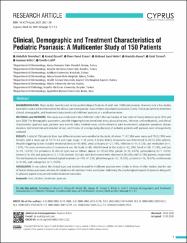Clinical, Demographic and Treatment Characteristics of Pediatric Psoriasis: A Multicenter Study of 150 Patients

Göster/
Erişim
info:eu-repo/semantics/openAccessTarih
2021Yazar
Demirbaş, AbdullahÖzyurt, Kemal
Elmas, Ömer Faruk
Metin, Mahmut Sami
Atasoy, Mustafa
Tursen, Ümit
Kilitçi, Asuman
Lotti, Torello
Üst veri
Tüm öğe kaydını gösterKünye
Demirbaş, A., Özyurt, K., Elmas, Ö. F., Metin, M. S., Atasoy, M., Türsen, Ü., ... & Lotti, T. (2021). Clinical, Demographic and Treatment Characteristics of Pediatric Psoriasis: A Multicenter Study of 150 Patients.Özet
BACKGROUND/AIMS: Many studies have focused on the epidemiological features of adult and childhood psoriasis. However, only a few studies have been conducted to demonstrate the clinical and demographic characteristics of pediatric psoriasis in Turkey. This study aimed to determine clinical, demographic, and treatment characteristics of childhood psoriasis in a multicenter series.MATERIALS and METHODS: This study was conducted in four different centers that are located in four cities of Turkey between June 2016 and June 2020. The demographic parameters, possible triggering factors (emotional stress, physical trauma, infection, and medication), and clinical characteristics (psoriasis type, psoriasis area severity index, involved areas, nail involvement, joint involvement, subjective symptoms, disease duration, last treatments and duration of use, and history of accompanying diseases) of pediatric patients with psoriasis were retrospectively analyzed.RESULTS: A total of 150 patients from four different centers were enrolled in the study, of whom 71 (47.30%) were males and 79 (52.70%) were females, with a mean age of 13.71 +/- 42 years (age range: 1-18 years). A family history of psoriasis was determined in 20 (13.33%) patients. Possible triggering factors included emotional stress (n=90, 60%), physical trauma (n=21, 14%), infection (n=14, 9.33%), and medication (n=1, 1.67%). The most common area of involvement was the trunk (n=69, 46%) followed by the scalp (n=42, 28%), hand (n=20, 13.33%), and face (n=19, 12.67%). The prevalence of clinical types was as follows: plaque (n=125,83.33%), guttate (n=10, 6.67%), palmoplantar (n=7, 4.67%), inverse (n=6, 4%), and pustular (n=2, 1.33%) psoriasis. Nail and joint involvement were observed in 30 (20%) and 15 (10%) patients, respectively. The last treatments received included topical treatment (n=101, 67.33%), phototherapy (n=23, 15.33%), acitretin (n=16,10.67%), methotrexate (n=9, 6%), and cyclosporine (n=1, 0.67%).CONCLUSION: In our cohort, the clinical types and treatments used for childhood psoriasis were similar to those of other studies, but the rate of family history was lower, whereas the incidence of emotional stress was higher. Addressing the psychological impacts of psoriasis along with its physical aspects may provide better treatment outcomes.
Kaynak
Cyprus Journal Of Medıcal ScıencesCilt
6Koleksiyonlar
- WoS İndeksli Yayınlar Koleksiyonu [3255]
- Yayın Koleksiyonu [59]

















